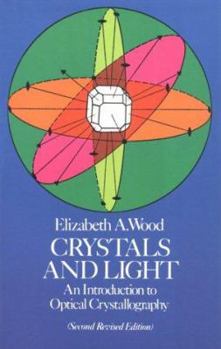Crystals and Light
(Book #5 in the Van Nostrand Momentum Book Series)
A concise yet comprehensive study of the behavior of light in crystals, this volume's topics range from space lattices and point groups to polarization and dispersion. "A clear, concise, and carefully... This description may be from another edition of this product.
Format:Paperback
Language:English
ISBN:0486234312
ISBN13:9780486234311
Release Date:June 1977
Publisher:Dover Publications
Length:156 Pages
Weight:0.45 lbs.
Dimensions:0.4" x 5.4" x 8.5"
Related Subjects
Chemistry Crystallography Physics Science Science & Math Science & Scientists Science & TechnologyCustomer Reviews
2 ratings
Good introduction for beginners
Published by Thriftbooks.com User , 20 years ago
The ability of calcite crystals to display double diffraction is interesting and one of the more popular demonstrations in physics classes all over the world. This book gives a good introduction to optical cystallography and is written for individuals that have no previous background in optics or materials science. It goes without saying that optical crystallography is of enormous importance technologically, and employs thousands of technicians, engineers, and scientists. There is not one part of this field that is not interesting, and readers will see why when perusing this book. Crystallography makes heavy use of a branch of mathematics called group theory, in order to describe the symmetries of crystals. The author uses the concept of a group in this book, but only descriptively, so as to keep the book geared toward a general audience. For example, a "point group" is defined as a collection of operations on an object that leave one point in the object fixed and also preserves distances between the points constant. The author gives examples of symmetry operations that cannot be part of a group. She then goes on to show that not all possible point groups can be used to describe the symmetry of arrangement of atomic planes in crystals, and thus the number of possible point groups is 32. The includes two tables of all 32 of these crystallographic point groups, one table where the point groups are listed by symbols with the symmetry elements of each group tabulated, the other table composed of diagrams of the symmetry elements and their stereographic projections. Readers will still have to know some elementary mathematics, such as trigonometry, in order to appreciate the Bragg law of X-ray diffraction. The importance of this law cannot be overstated, as the use of it gives us information on the distances between the crystallographic planes. The author also includes some brief history of the discoveries in crystallography. In addition, color photographs are included to illustrate the optical phenomena between crossed polarizers, uniaxial interference, and general interference. With a few cheap polarizers and optical materials, readily available from scientific supply houses, readers will be ready to experiment with the concepts that are discussed in this book.
Good for the Amateur
Published by Thriftbooks.com User , 26 years ago
The first paragraph of the Preface is herein quoted: "This is a book about the behavior of light in crystals. Since it is written for people with no previous training in either the subject of crystals or the subject of light, the first six chapters tell what sort of thing a crystal is and the seventh tells about some of its physical properties. The remaining chapters describe some of the effects produced on light, mainly polarized light, by crystals and so constitute an introduction to optical crystallography." My copy of several years ago came with a piece of polarizing film; don't know whether this is still included, if not one can order a sheet from Edmund Scientific catalog. This little book is clearly, lucidly written for the student and the amateur.





